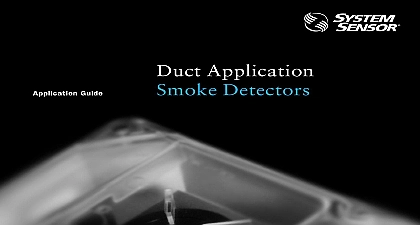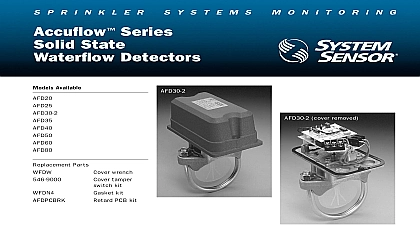System Sensor AV Appliance

File Preview
Click below to download for free
Click below to download for free
File Data
| Name | system-sensor-av-appliance-8219437056.pdf |
|---|---|
| Type | |
| Size | 1.11 MB |
| Downloads |
Text Preview
A P P L I C A T I O N S G U I D E Visible Guide Visible Guide 2 Requirements 6 Is Required To Comply 3 Visible Appliances for ECS MNS Applications 6 Is The ADAAG 3 Drop Calculations 7 is the Coverage and Enforcement of the ADA 3 Supply Considerations 8 Is Mode vs Mode Operation 3 is Meant by Polar Light Distribution 8 Should Strobes Be Located 4 Material 10 Many Strobes Should Be Used 5 About Photosensitive Epilepsy and Strobe Flash Rates 5 The Need for an Audible Visible Compliance Reference Guide installation and performance requirements for audible visible appliances in general are addressed in three documents 1 ADAAG with Act Accessibility Guidelines the Federal Civil Rights Law prohibiting discrimination on the basis of disability 2 ANSI 117.1 Usable Buildings and Facilities a standard on accessibility designed to be adopted as part of a building code and 3 NFPA 72 the National Fire Code and Signaling Code 2010 or 2013 edition an installation standard for fire alarm systems normally not adopted directly into law but refer in a building code as the standard to be followed the past audible visible requirements of NFPA 72 differed from the Americans with Disabilities Act Accessibility Guidelines ADAAG and other acces standards such as ANSI 117.1 2003 Accessibility and Usable Buildings and Facilities Section 702.1 of ANSI 117.1 2009 reads and visual alarms and notification appliances shall be installed in accordance with NFPA 72 listed in Section 105.2.2 be powered by a com light and power source be permanently connected to the wiring of the premises electric system and be permanently installed Therefore the are consistent in regards to the type visual intensity and amount of visual alarm notification appliances i e strobes to use within a given as well as the mounting and placement of such appliances On Friday July 23 2010 Attorney General Eric Holder signed final regulations revis the Department ADA regulations including its ADA Standards for Accessible Design As such the 2010 edition of the ADA Standards have been with the latest editions of NFPA 72 Sensor has prepared this Reference Guide in an effort to help promote understanding and awareness of the issues that affect specifying engi installers and the enforcement authorities We hope to increase the probability of proper installation and reduce the possibility of misapplication audible visible appliances in the commercial market place VISIBLE APPLIANCE REFERENCE GUIDEfirealarmresources com 1 Is Required To Comply entails adhering to the adopted model building code NFPA installation and UL 1971 UL 1638 UL 464 product performance stan It is always prudent to consult with your Authority Having Jurisdiction and or local fire marshal to ensure that you are meeting all applica codes and standards The diagram below illustrates the five steps to NFPA 72 Chapter 18 ANSI 117.1 Model Building Code State Local Code Local Authority Having Jurisdiction AHJ Installation Standard ADA Exclusions to ADA Coverage With Federal Law UL 1971 Public Mode UL 1638 Private Mode UL 464 Standard Corridor Sleeping Non Sleeping Area Be Protected Public Private Operating Mode Religious entities and private clubs Strictly residential private apartments and homes Federal buildings covered by the Architectural Barriers Act of 1968 and currently by the Uniform Federal Accessibility Standards a corporation wholly owned by the government of the U S or Indian tribe Multi family residential facilities generally covered by the Fair Housing Act of 1988 FHAA and its related regulations and 3 is the Coverage and Enforcement of the ADA ADA comprises four titles that define and prohibit discrimination on basis of disabilities within specific areas Fire safety signaling devices addressed under Title III which covers public accommodations services including transportation Compliance is enforced by the of Justice or the Department of Transportation in areas of transportation Safety Signaling Devices Are Covered Under Title III Steps to Compliance Americans with Disabilities Act 2 Is The ADAAG I Employment by Equal Employment Opportunity Commission EEOC ADAAG is the official standard for accessible design under Title III of ADA It covers only new construction and alterations made to the fire system undertaken by facilities covered by the ADA The ADAAG written by the Access Board The Access Board in one of its infor bulletins states the ADA is civil rights law compliance and enforcement of its implementing regulations are not overseen by local building code official but are exercised through private suit or by federal agencies when discrimination the probability of dis on the basis of disability alleged states have adopted ADAAG as their accessibility code and imple its provisions through state and local building code officials in the way as other applicable building regulations are applied reviewed enforced Many jurisdictions are expected to submit their building and or standards for review by the Department of Justice Standards meet or exceed the minimum accessibility requirements of the ADA will certified The model codes including ANSI 117.1 and the International Code have sought to coordinate accessibility provisions through review and technical assistance from DOJ compliance does not relieve the designer from complying with provisions of a state or local access code such a code con more stringent requirements they must be incorporated Conversely of ADAAG or certification of the equivalence of a state local code not relieve covered entities of their responsibilities to meet the acces standards imposed by the ADA NFPA 72 National Fire Alarm and Code provides guidance for equivalent facilitation to comply ADA requirements See Performance Based Alternative section 13 to ADA Coverage Individual employee offices and work stations Arrangements should be however to comply with the provisions of Title I which addresses reasonable accommodations e g a visible signal for an who is deaf or hard of hearing II Public Services Enforced by Department of Justice DOJ of Transportation DOT III Public Accommodations and Commercial Facilities by Department of Justice DOJ IV Miscellaneous Provisions 4 Is Mode vs Mode mode applications are those where a signal is known to be in place where someone is trained to take additional action upon notification the alarm signal Examples include control rooms nurses stations guard desks These emergency signaling applications may not have meet ADA requirements and may be satisfied through installation of UL appliances mode operation includes audible or visible signaling to occupants inhabitants of the area protected by the fire alarm system Americans with Disabilities Act Section 301 7 defines a public accom as any facility that is privately operated affects commerce with operation and falls into one

